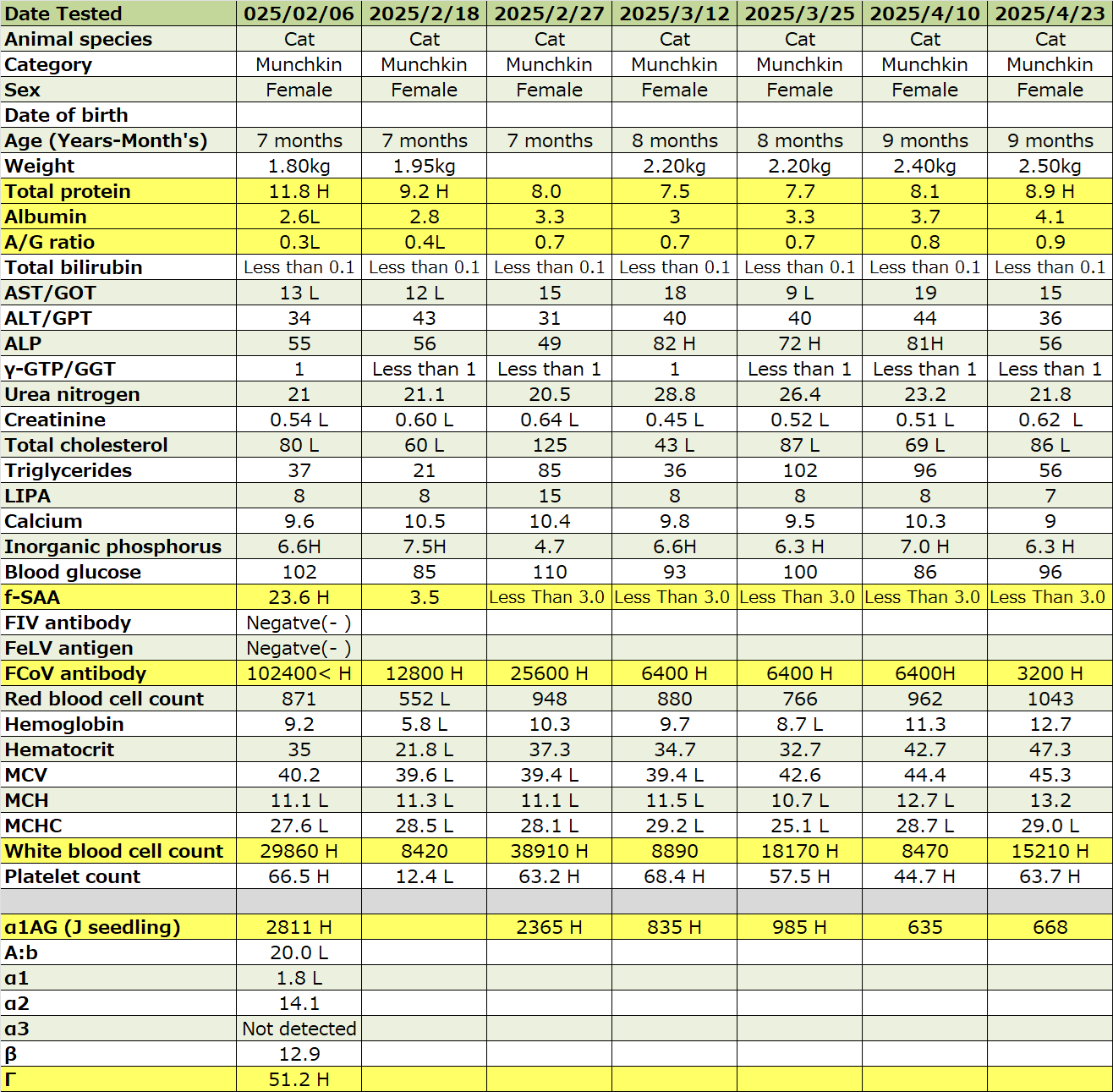
CASE STUDIES
on
CBD Administered to Dogs and Cats
1.Feline: AIDS
2.Canine: Kidney Failure
3.Canine: Pancreatitis and Kidney failure
4.Feline: Kidney Failures
—–4-1 Japanese Cat
—–4-2 Western Cat Mixed
—–4-3 Japanese Cat
5.Feline: Kidney Failure by Intestinal Obstruction
6.Feline: Acute Kidney Failure
7.Canine: Hepatitis
—–7-1 Miniature Dachshund
—–7-2 Shiba Inu
—–7-3 Toy Poodle
8.Feline: Hepatitis
9.Canine: Lymphocytic Leukemia
10.Canine: Herniated Disc Disease
11.Feline: Infectious Peritonitis
—–11-1 British Shorthair
—–11-2 Japanese Cat
—–11-3 Bengal Cat
—–11-4 Ragdoll
—–11-5 Munchkin
In recent years, CBD, which has no psychoactive effects, has been attracting attention because it shows various therapeutic effects. Cannabinoids exert their effects through various receptors. There are two cannabinoid receptors, CB1 and CB2, both of which are G protein-coupled receptors. CB1 receptors are mainly expressed in nerve cells and regulate neurotransmission. CB2 receptors are expressed in non-neuronal cells outside the central nervous system, especially lymphocytes and macrophages. In addition to these receptors, CBD is thought to exert its effects through GPR55, 5-HT, and PPAR receptors, and it has been reported that it has anti-inflammatory, analgesic, antioxidant, neuroprotective, immunomodulatory, and tranquilizing effects, as well as effectiveness in the prevention and treatment of diabetes, cancer, etc. Here, the therapeutic effects of CBD are shown in blood test results, etc.
When using CBD, it is recommended that first focus is given on its antioxidant and anti-inflammatory effects and use it in cases where the CRP value in Canine and the f-SAA value in Feline is high. Please check the progress of the case data to see the therapeutic effect. The antioxidant effect of CBD is something which was never experienced, and it seems that this is connected to the therapeutic effect. Furthermore, it is effective in skin diseases and is expected to have high cell regeneration ability. It also helps in the surgical field, such as promoting wound healing and enhancing bone regeneration. In addition, it suggests that it can bring about improvement in constipation and nerve transmission failure in cats, and symptoms that are difficult to overcome with Western medicine. However, it is not necessarily effective for all diseases. If there is no improvement in symptoms after 2 to 3 weeks of administration, it may be the case where treatment other than CBD should be sought.
1.Feline: AIDS
Case number: F-001KRe
Cat, Japanese cat, neutered male, born 2010/04/01, 14 years and 1 month old, 3kg
Date of first visit: 2024/05/11
<Symptoms>
It was brought in with no appetite and difficulty maintaining his posture while lying down. Jaundice was noted on the visible mucous membranes.
<Treatment>
0.3ml of Pure Gold was used, approximately 0.1ml/kg. Since then, it has been given orally every day.
On 05/11 and 05/12, 250ml of lactated Ringer’s was administered subcutaneously and a new quinolone antibiotic was injected each day.
As the dog’s appetite had returned slightly on 05/12, Pure Gold and new quinolone antibiotics were given orally from 05/13 onwards. Due to the owner’s circumstances, we chose a treatment method that limited the number of visits to the hospital.
From 05/26, as it’s overall condition improved, oral administration of quinolone antibiotics was discontinued, and Pure Gold and liver support agents were prescribed.
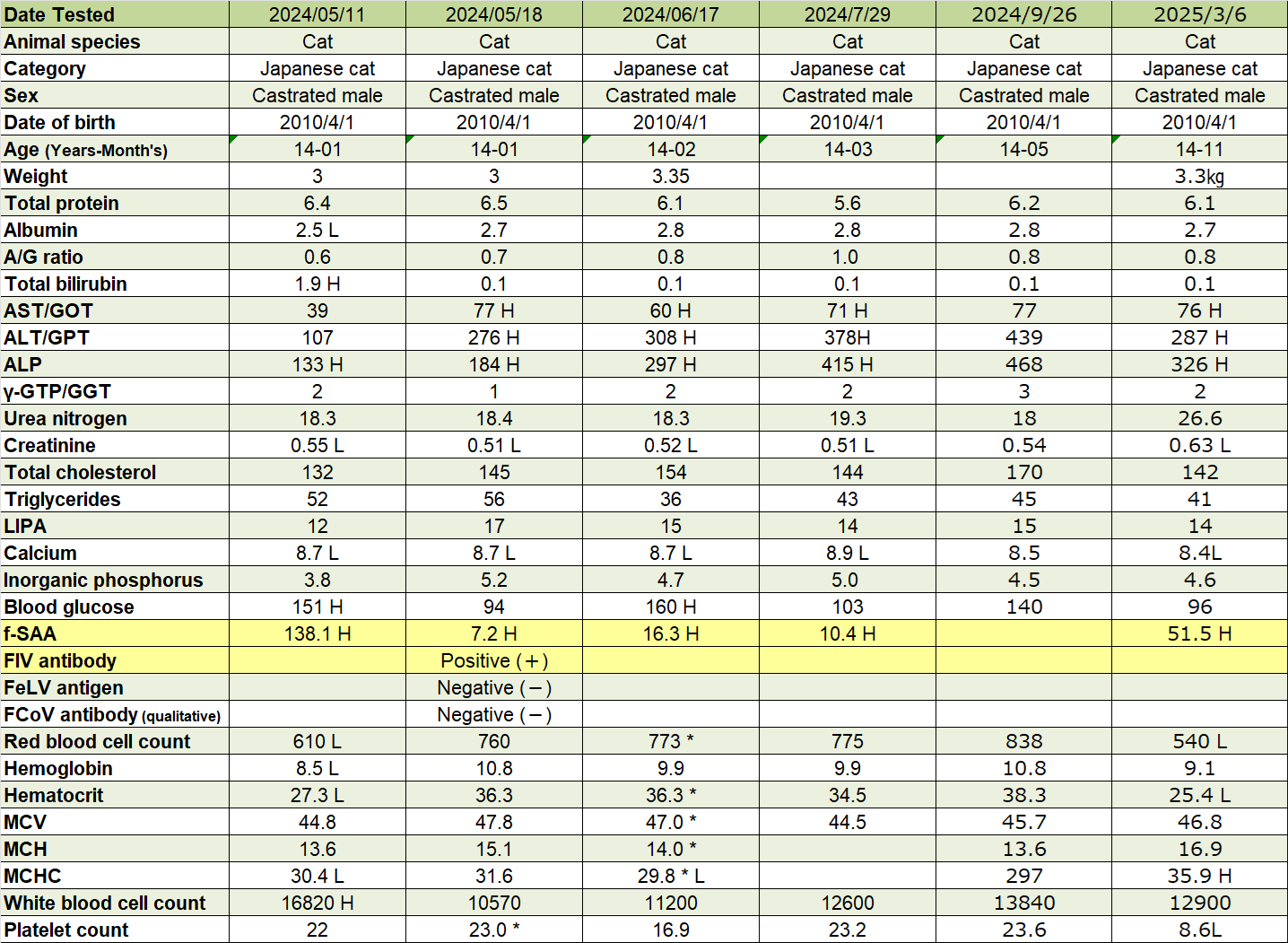
2.Canine: Kidney Failure
Case number: C-002MLe
Dog, Spitz, neutered male, born 2016/04/26, 8 years and 0 months, 8.3kg
Date of first visit: 2024/05/07
<Symptoms>
It was brought in due to loss of appetite and lack of energy.
<Treatment>
Pure Gold 1.0ml, approximately 0.1ml/kg was used. Since then, it has been administered orally every day.
From 05/07, 500ml of lactated Ringer’s solution was administered subcutaneously every day, and Pure Gold was administered.
On 05/12, the appetite returned slightly, so oral administration of Kremezin, Oral prostacyclin (PGI2) derivatives, and prolacto iron tabs was added. From 06/20, the anemia became severe, so Epogin injections were also administered.
Due to various circumstances of the owner, it was chosen to limit the number of blood tests.
Since 07/20, the general condition has been good, so 500ml of lactated Ringer’s solution was administered subcutaneously 2-3 times a week, and Pure Gold, Kremezin, and Oral prostacyclin (PGI2) derivatives were administered.
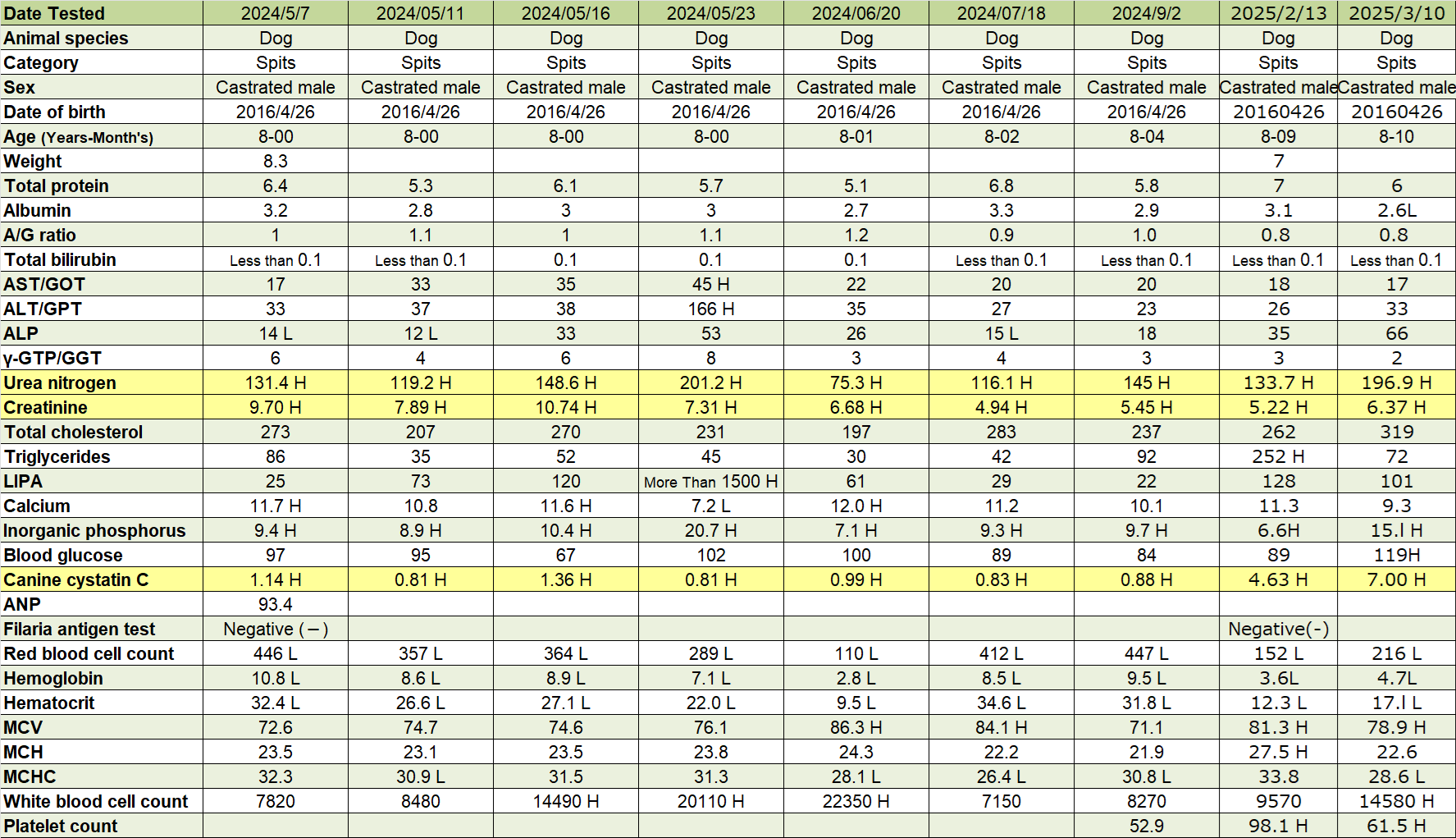
Video Clip ②
<09/06、Video showing whole body condition>
3.Canine: Pancreatitis and Kidney failure
Case number: C-003MMe
Dog, toy poodle, male, born 2008/01/01, 16 years and 8 months, 4.9kg
Date of first visit: 2024/07/08
<Symptoms>
It was brought in with convulsive tic symptoms.
<Treatment>
Pure Gold 0.5ml, approximately 0.1ml/kg was used. Since then, it has been administered orally every day.
From 07/08, 250ml of lactated Ringer’s solution was administered subcutaneously every day, along with prednisolone and Pure Gold.
On 07/13, the neurological symptoms caused by uremia had eased slightly, so treatment for the pancreatitis was actively undertaken. Up until this point, it had been judged that it’s was in very critical condition and hospitalization would be difficult.
By 07/19, It’s appetite had stabilized, so it was decided that 250ml of lactated Ringer’s solution would be administered subcutaneously every other day.
From then on, while continuing treatment for anemia, the patient was given subcutaneous infusions about once a week and Pure Gold was administered daily.
Unfortunately, it died on October 15th, not from kidney failure, but from old age.
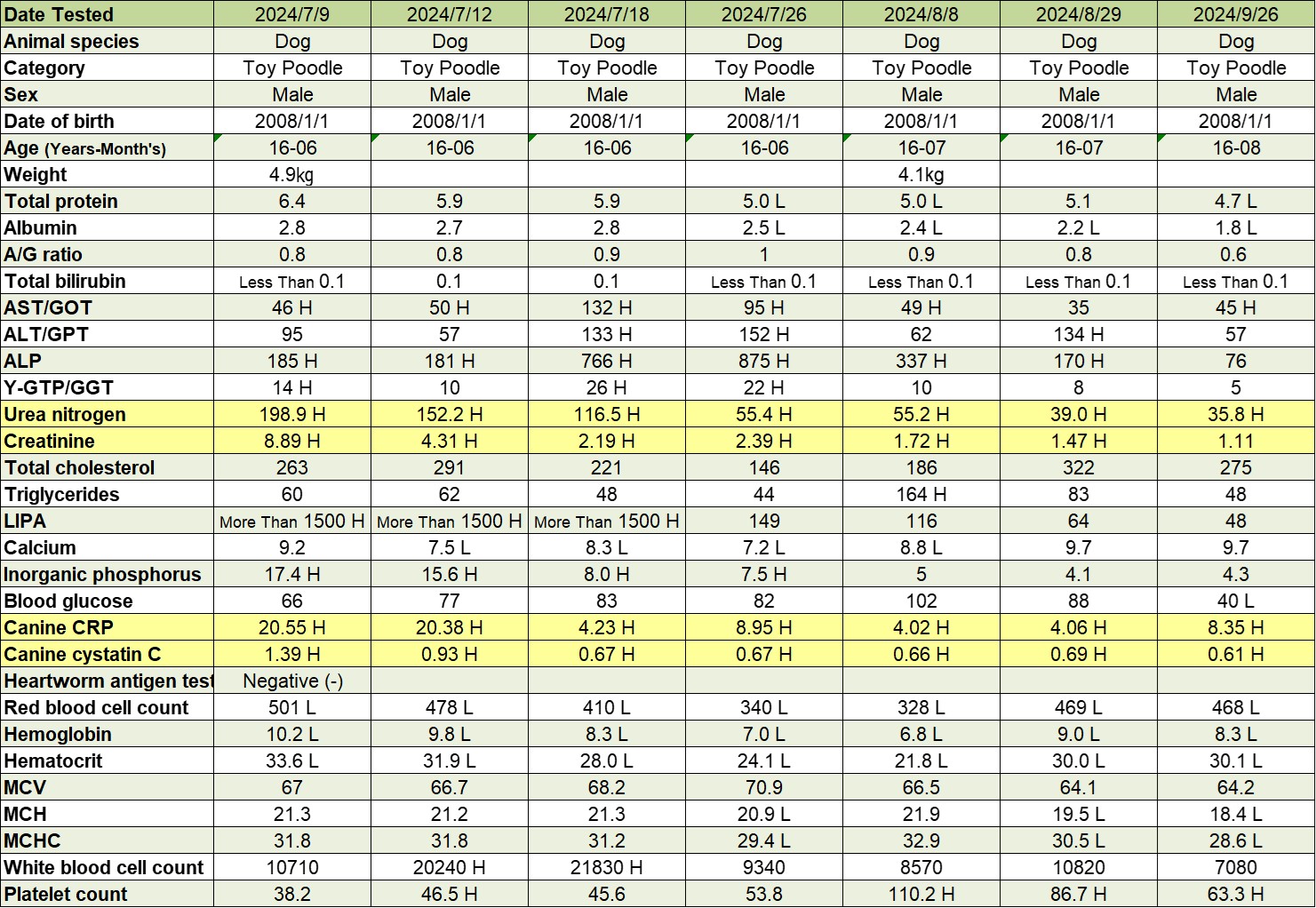
4.Feline: Kidney Failure
4-1 Japanese Cat
Case number: F-004INe
Cat, Japanese cat, neutered male, born 2009/04/01, 15 years and 5 months, 4.7kg
Date of first visit: 2024/09/06
<Symptoms>
It was brought in with no appetite and lack of energy. It was severely dehydrated.
<Treatment>
Pure Gold 0.5ml, approximately 0.1ml/kg was used. Since then, it has been administered orally every day.
From 09/06, 300ml of lactated Ringer’s acid was administered as subcutaneous fluid replacement every day, along with antibiotic injections of prednisolone and ampicillin.
On 09/11, the patient’s appetite returned slightly and his energy level improved, so from this date onwards, 300ml of Pure Gold and lactated Ringer’s acid were administered as subcutaneous fluid replacement. Injections of prednisolone and other drugs were no longer administered.
On 09/17, the kidney test values also declined slightly, and the patient’s overall condition was such that he could live a normal daily life, so 250ml of lactated Ringer’s acid was administered as subcutaneous fluid replacement every other day. Pure Gold, Kremezin, and Oral prostacyclin (PGI2) derivatives were also administered as oral medications every day. As the patient’s diet had become stable, a Kidney Care diet was also started.
Unfortunately, despite all the treatment, it passed away on October 11th, but he managed to maintain his health for about a month prior to that, allowing it to spend some precious time with the owner.
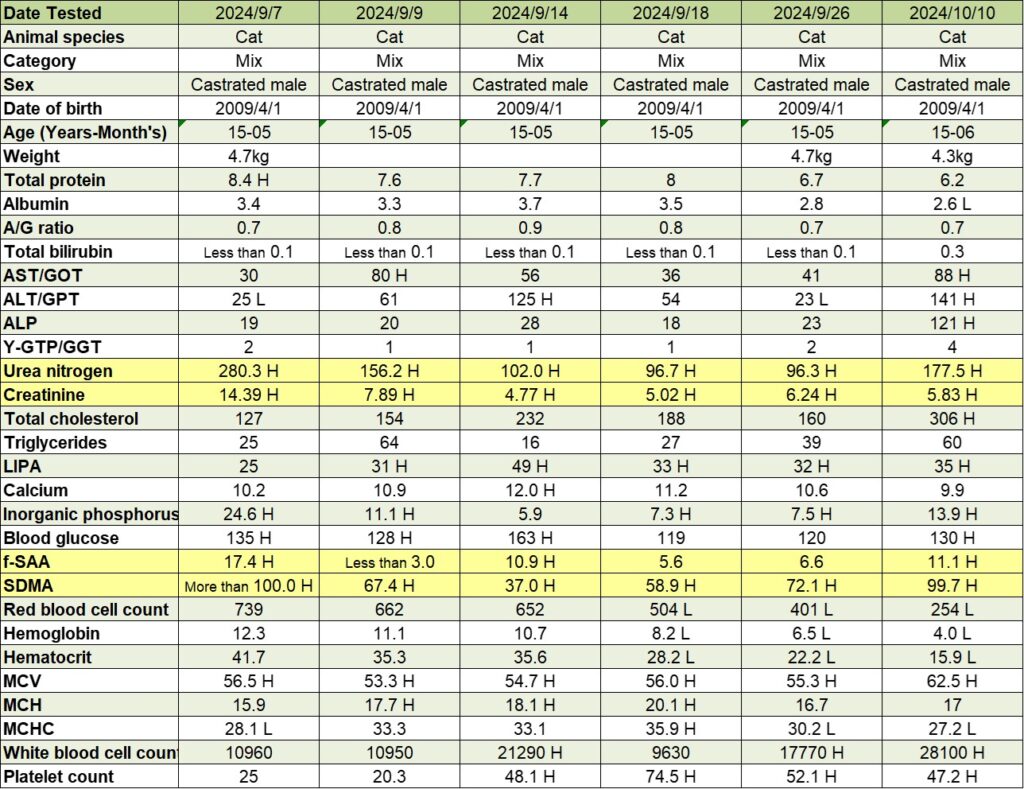
Back to Page Top
4-2 Western Cat Mixed
Case number: F-015 KN
Cat, Western cat mix, neutered female, born 2012/04/01, 12 years and 10 months, 3.9kg
Date of first consultation: 2023/10/14
<Symptoms>
A case in which renal failure was managed by continuous subcutaneous fluid replacement about once a week showed vomiting and diarrhea symptoms from 25/01/27. Symptoms were cured with new quinolone antibiotics and antiemetics, but weight decreased from 25/01/17 4.25kg to 25/02/17 3.9kg. Appetite and food intake gradually decreased. Same with vitality.
<Treatment>
Pure Gold 0.3ml, approximately 0.1ml/kg. Since then, it has been administered orally twice a day every day.
From 02/17 to 02/22, subcutaneous fluid replacement with 250ml of lactated Ringer’s and prednisolone injections were administered every day. Prednisolone was selected as a concomitant medication due to suspicion of acute renal failure. In addition, the patient has been taking a PGI 2️ derivative preparation since the initial consultation.
Since 02/23, the patient’s health has improved slightly, so a treatment method was selected in which the visit interval was changed to every 3 days. Since then, the visit interval has been gradually extended from 03/04 to every 4 days, from 03/25 to every 5 days, and from 04/19 to once a week, but the patient’s health is currently good and kidney values are being managed within a certain range.
An X-ray taken on 02/18 revealed a right kidney stone, and it is speculated that this stone may have had some effect inside the kidney, causing the acute renal failure to worsen. Although there is no clear evidence that the administration of Pure Gold twice a day orally and prednisolone by injection improves symptoms and renal values, we believe that the anti-inflammatory effects of the two drugs, the blood flow enhancing effects of CBD, and the cell regeneration enhancing effects are all contributing to good management. However, this is a case in which we will continue to be vigilant for the recurrence of renal failure symptoms in the future.

<2025/02/18>
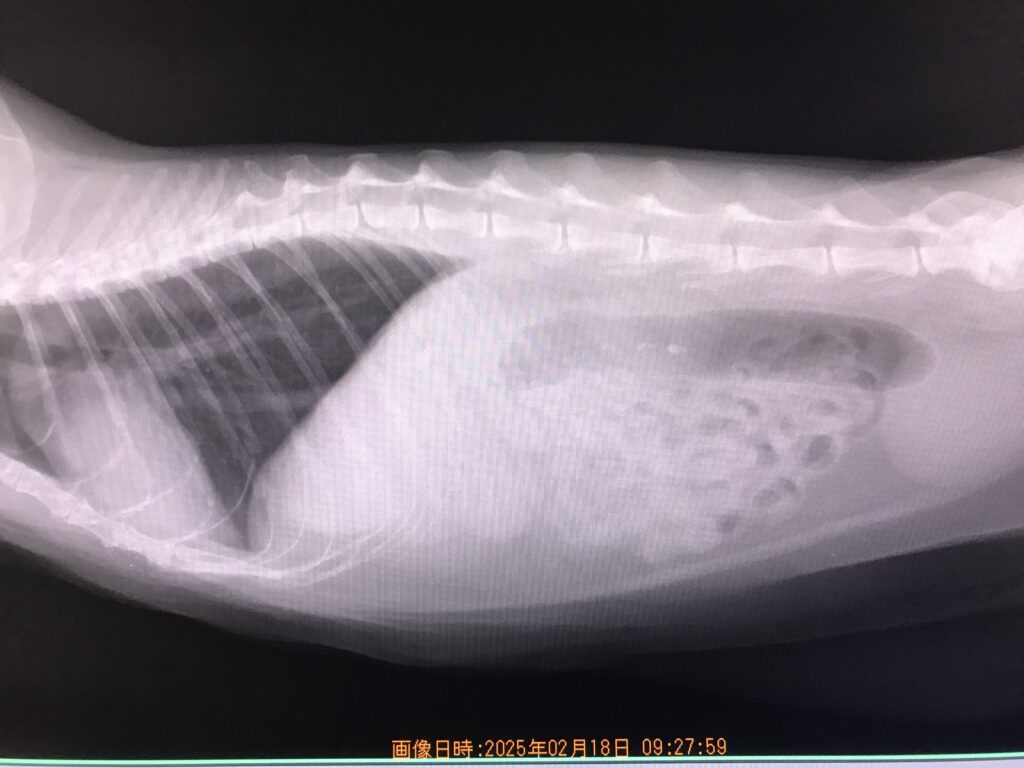
<2025/02/18>
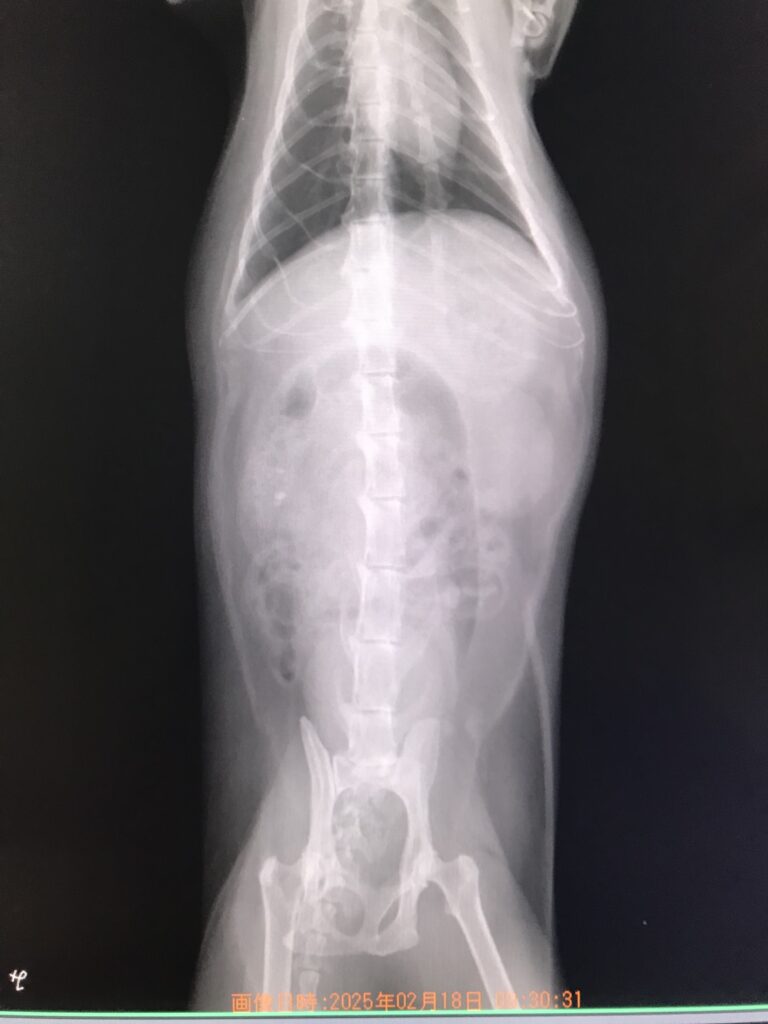
4-3 Japanese Cat
Case number: F-016HC
Cat, Japanese cat, neutered female, born 2018/07/01, 6 years and 8 months, 2.9kg
First visit: 2025/02/08
<Symptoms>
Came to the hospital complaining of loss of appetite and lack of energy.
<Treatment>
Used Pure Gold 0.3ml, approximately 0.1ml/kg. Since then, it has been administered orally twice a day.
On 02/08, 02/10, 02/11, and 02/13, subcutaneous fluid replacement with 250ml of lactated Ringer’s and prednisolone injections were administered each day. Since the cat had previously been diagnosed with immune system abnormalities, prednisolone was selected as a concomitant medication.
On 02/10, the cat showed a slight appetite, and due to the owner’s circumstances, a treatment method was selected that limited the number of visits to the hospital. In this case, the f-SAA value was high in the test results on 02/08, and immune-mediated renal failure was strongly suspected.
From 02/15, the patient’s overall condition improved and test results returned to normal to a certain extent, so subcutaneous fluid therapy was discontinued and treatment was switched to oral administration of Pure Gold twice a day only. From then until 03/15, urea nitrogen and creatinine values remained within normal limits, allowing for good management. However, f-SAA and SDMA values remained abnormal in every test, and caution was exercised against a recurrence of renal failure symptoms.
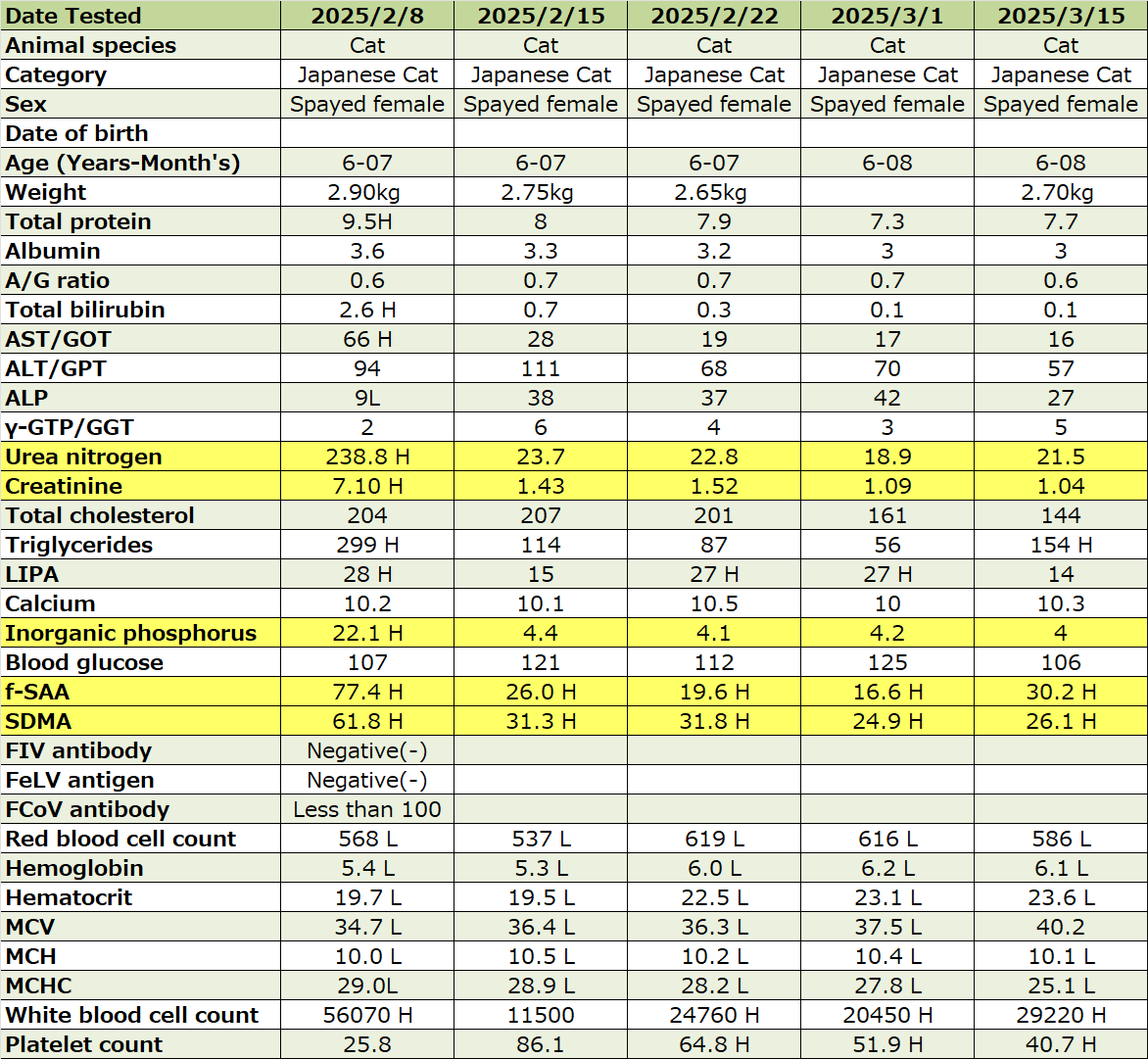
Back to Page Top
5.Feline: Kidney Failure by Intestinal Obstruction
Case number: F-005IAe
Cat, Russian Blue, neutered female, born 2019/02/27, 5 years and 5 months, 3.1kg
First visit: 2024/08/13
<Symptoms>
It was brought in due to lack of apitite.
<Treatment>
Pure Gold 0.3ml, approximately 0.1ml/kg, was used. Since then, it has been administered orally every day.
From 08/13, 250ml of lactated Ringer’s fluids were administered subcutaneously every day, along with prednisolone, a new quinolone antibiotic, metopramide, and Pure Gold. In this case, intestinal obstruction was suspected and medication was used. By 08/16, the appetite had stabilized, and all treatment was completed by 08/17. It is currently recovering well.
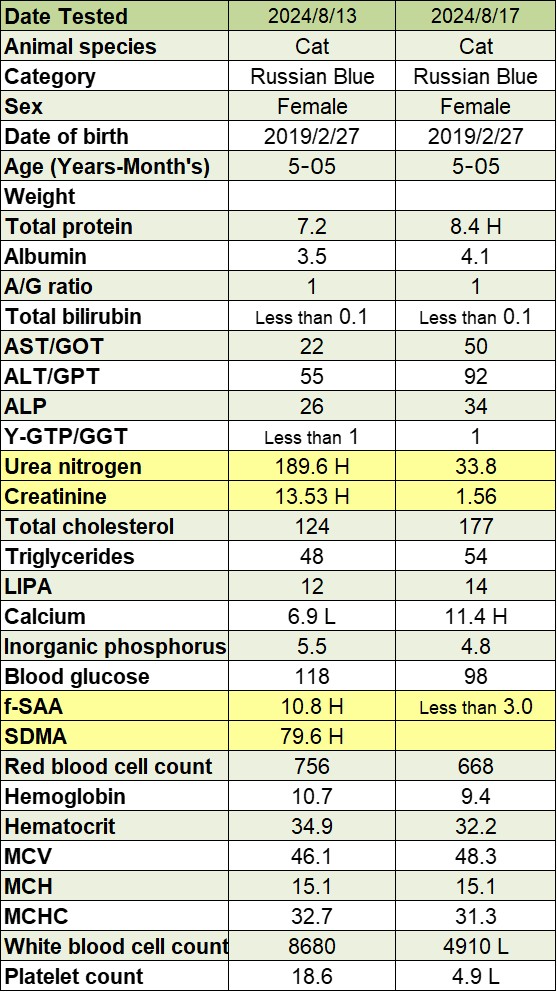
6.Feline: Acute Kidney Failure
Case number: F-006KOe
Cat, Japanese cat, unneutered male, born 2020/08/01, 3 years and 8 months, 5.3kg
First visit date: 2024/05/13
<Symptoms>
It was brought in as urine could not be released.
<Treatment>
Pure Gold 0.5ml was used, approximately 0.1ml/kg. It has been administered orally every day since then.
On 05/13, 05/14, and 05/16, 4-500ml of lactated Ringer’s solution was administered subcutaneously and a new quinolone antibiotic was injected each day. Due to various circumstances between the hospital and the owner, a treatment method was chosen that limited the number of visits to the hospital.
By 05/17, the condition had disappeared, so subcutaneous fluid administration, new quinolone antibiotics, and Pure Gold administration were all discontinued.
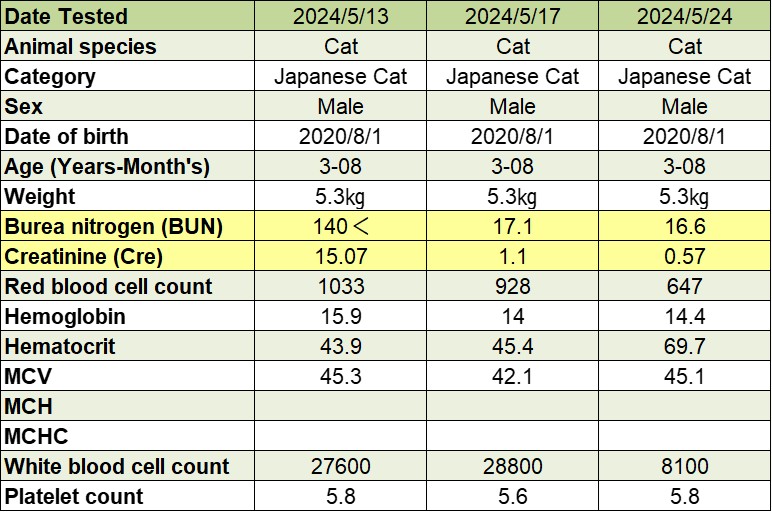
7.Canine: Hepatitis
7-1 Miniature Dachshund
Case number: C-007HBe
Dog, miniature dachshund, neutered female, born 2011/11/20, 12 years and 7 months, 4.8kg
First visit: 2024/06/27
<Symptoms>
It was bought in due to a 40°C fever and loss of energy. It had some appetite.
<Treatment>
Pure Gold 0.5ml, approximately 0.1ml/kg was used. Since then, it has been orally administered twice a day.
Each day, 250ml of lactated Ringer’s fluid is administered subcutaneously, and a new quinolone antibiotic and NSAID injection are administered. However, on 07/04, the CRP value did not decrease, so the NSAID was changed to prednisolone. Since then, It has been in good spirits and has a good appetite.
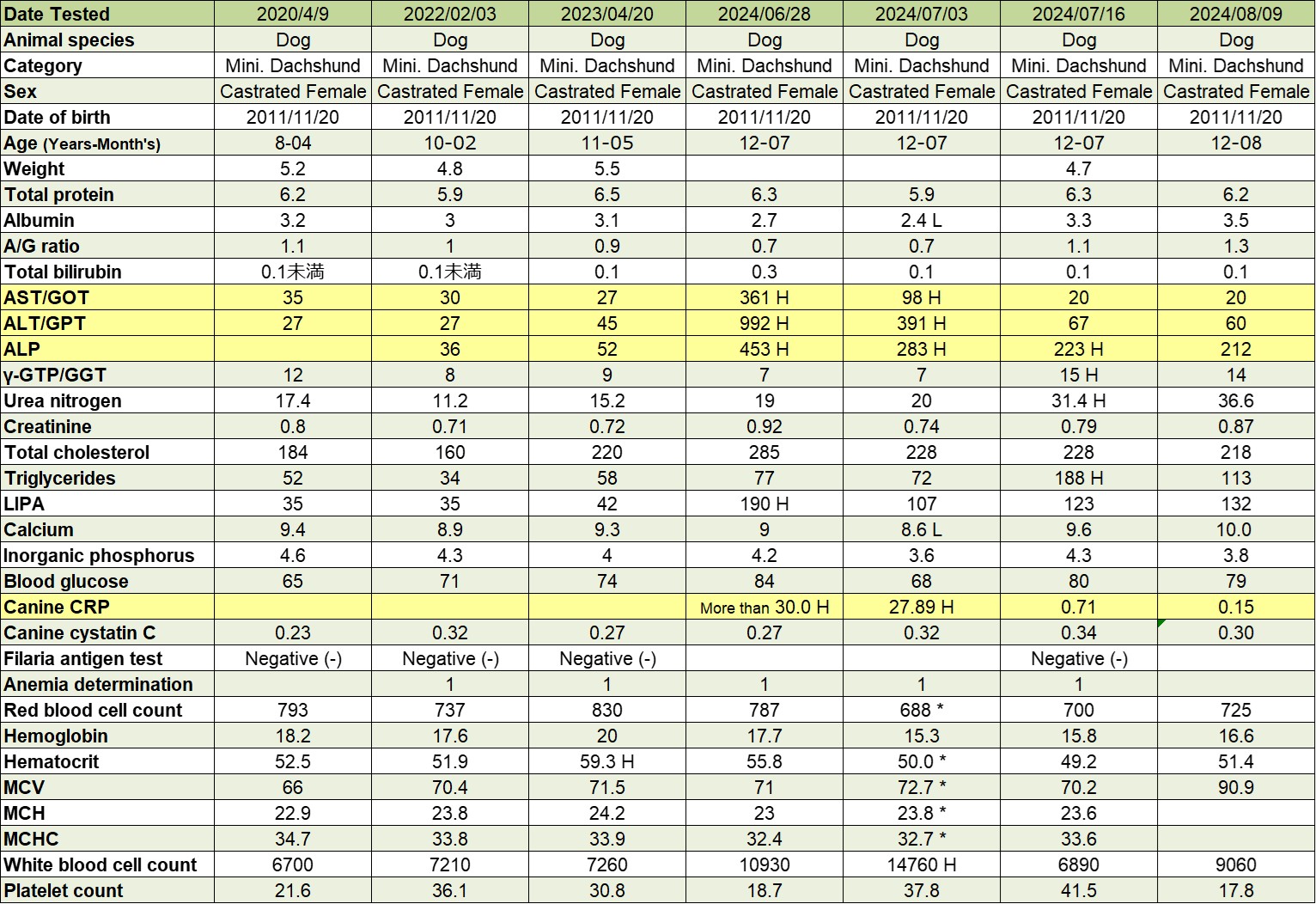
7-2 Shiba Inu
Case number: C-013ML
Dog, Shiba Inu dog, neutered female, born 2012/06/18, 13 years and 9 months, 9.5kg
First visit: 2025/03/27
<Symptoms>
Came to the hospital complaining of loss of appetite and lack of energy. Jaundice was observed on the visible mucosa.
<Treatment>
Used 1.0ml of Pure Gold, approximately 0.1ml/kg. Orally administered once a day thereafter. Daily intravenous drip of Ringer’s solution, injection of new quinolone antibiotics, and liver protectant. This case was severely injured, and the owner was informed that it would be difficult to visit the hospital every day due to the distance, so the dog was hospitalized for treatment. It is believed that the liver abnormality was caused by the ingestion of a toxic drug. On 03/31, the dog was in good health, had a good appetite, and the test results showed signs of improvement, so the dog was discharged at the owner’s request. Since then, Pure Gold 1.0ml has been orally administered once a day, and liver support agent twice a day. Subsequent test results showed improvement on 04/08 and 04/21, and treatment was completed on 04/21.
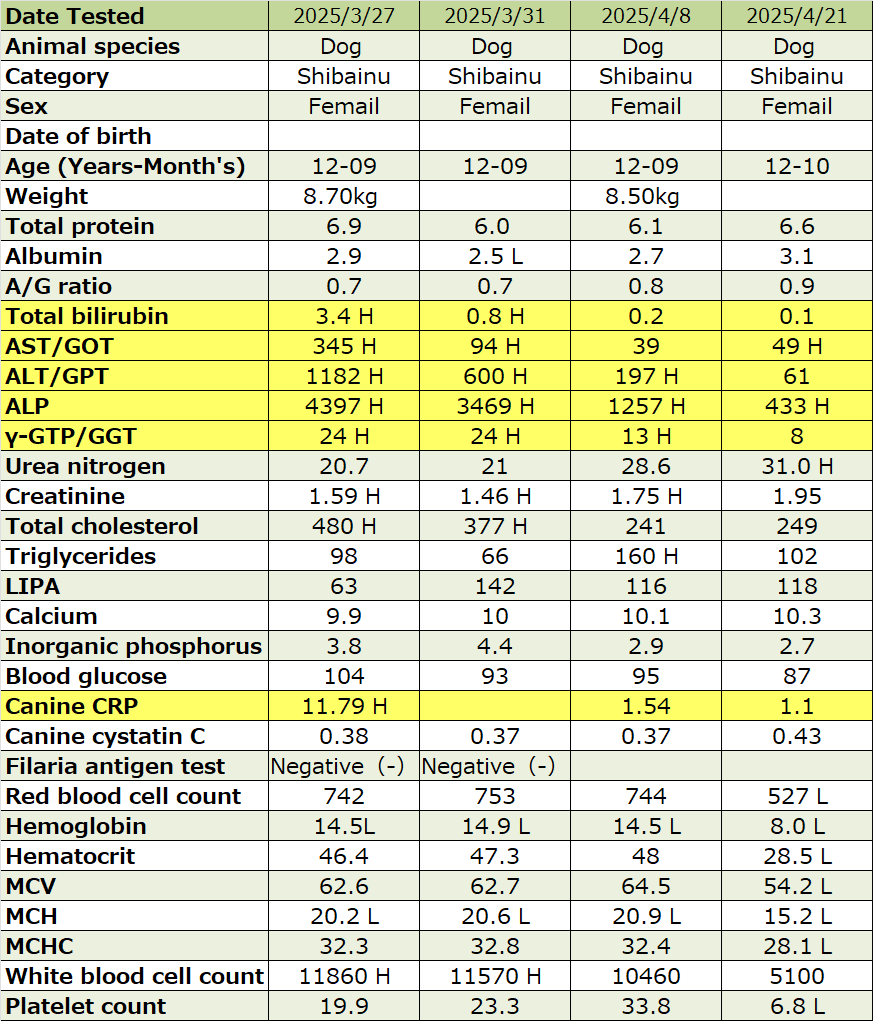
7-3 Toy Poodle
Case number: C-014KM
Dog, toy poodle, neutered female, born 2009/12/23, 15 years and 3 months, 2.7kg
First visit: 2025/04/11
<Symptoms>
Came to the hospital complaining of loss of appetite and lack of energy. Severe jaundice was observed on the visible mucosa.
<Treatment>
Used Pure Gold 0.3ml, approximately 0.1ml/kg. Orally administered once a day thereafter. Subcutaneous fluid replacement with 250ml of lactated Ringer’s, a new quinolone antibiotic, and a liver protector were administered every day. This case also had gastrointestinal symptoms, so antibiotics were selected and injected. The owner requested that the dog not be separated from her even for a moment, so outpatient treatment was performed. No liver abnormalities were found during the health check on 03/01, and it is suspected that the liver abnormalities were caused by the ingestion of toxic drugs. The appetite showed signs of improving immediately after treatment began, and the owner was able to visit the hospital with a little more peace of mind. By 04/17, the general condition had stabilized, so the patient was treated with subcutaneous fluid therapy using 250ml of lactated Ringer’s gel every other day, and from 04/25, once every three days. Pure Gold 0.3ml was administered orally once a day, and liver support agent once a day was administered orally at home. Subsequent test results showed improvement on 04/15 and 04/23, and an examination on 05/01 confirmed that liver and total bilirubin values had returned to normal, and treatment was terminated.
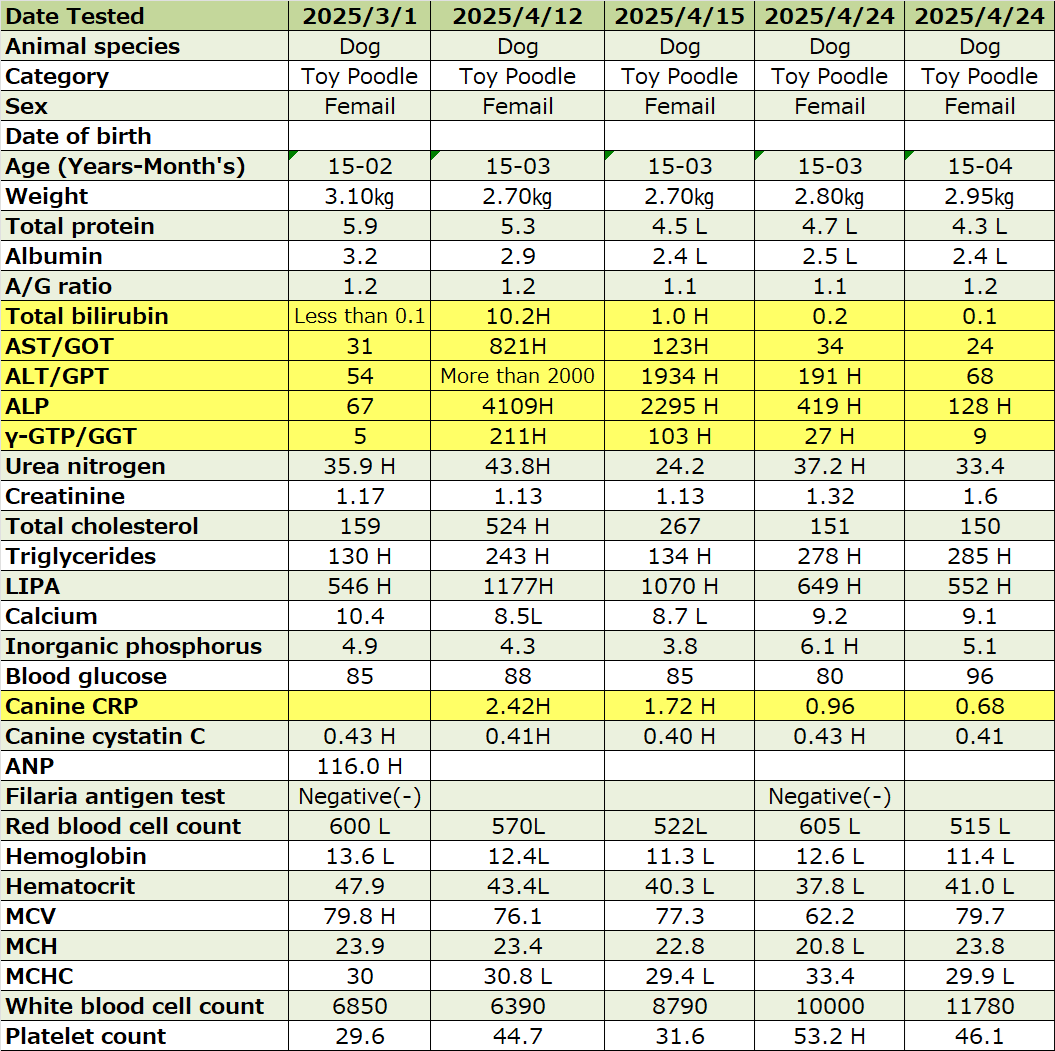
8.Feline: Hepatitis
Case number: F-017MR
Cat, Norwegian Forest Cat, neutered male, born 2022/11/26, 2 years and 1 month old, 5.8kg
First visit: 2025/01/07
<Symptoms>
Visited with complaints of body temperature of 40.0℃ and lack of appetite.
<Treatment>
Used Pure Gold 0.5ml, approximately 0.1ml/kg. Orally administered twice a day since then. Subcutaneous fluid replacement with 250ml of lactated Ringer’s and liver protector injections are administered daily. In this case, hepatitis due to viral infection was suspected, and Molnupiravir capsules were administered at 1/3 cap twice a day. Molnupiravir was administered orally until 01/15. The method of administration for Molnupiravir is to administer it for 5 days, so this was followed. At the owner’s request, and the appetite and energy improved the day after the visit, so outpatient treatment was performed. By 01/17, blood test results had improved significantly, and outpatient subcutaneous fluid therapy was discontinued. After that, Pure Gold 0.5ml was orally administered twice a day at home. Subsequent test results were good on 01/27, 02/06, 02/21, and 03/15, and from 03/15, Pure Gold 0.5ml was orally administered once a day. On 04/21, liver values were confirmed to be normal, and Pure Gold 0.5ml was orally administered every other day. Pure Gold is being administered at the owner’s request.
It is not clear whether the cause of infection was feline infectious peritonitis virus, but f-SAA, FcoV antibody titer, and α-1AG were continuously tested. As the author, I believe that there is a connection when observing the progress of antibody titers.
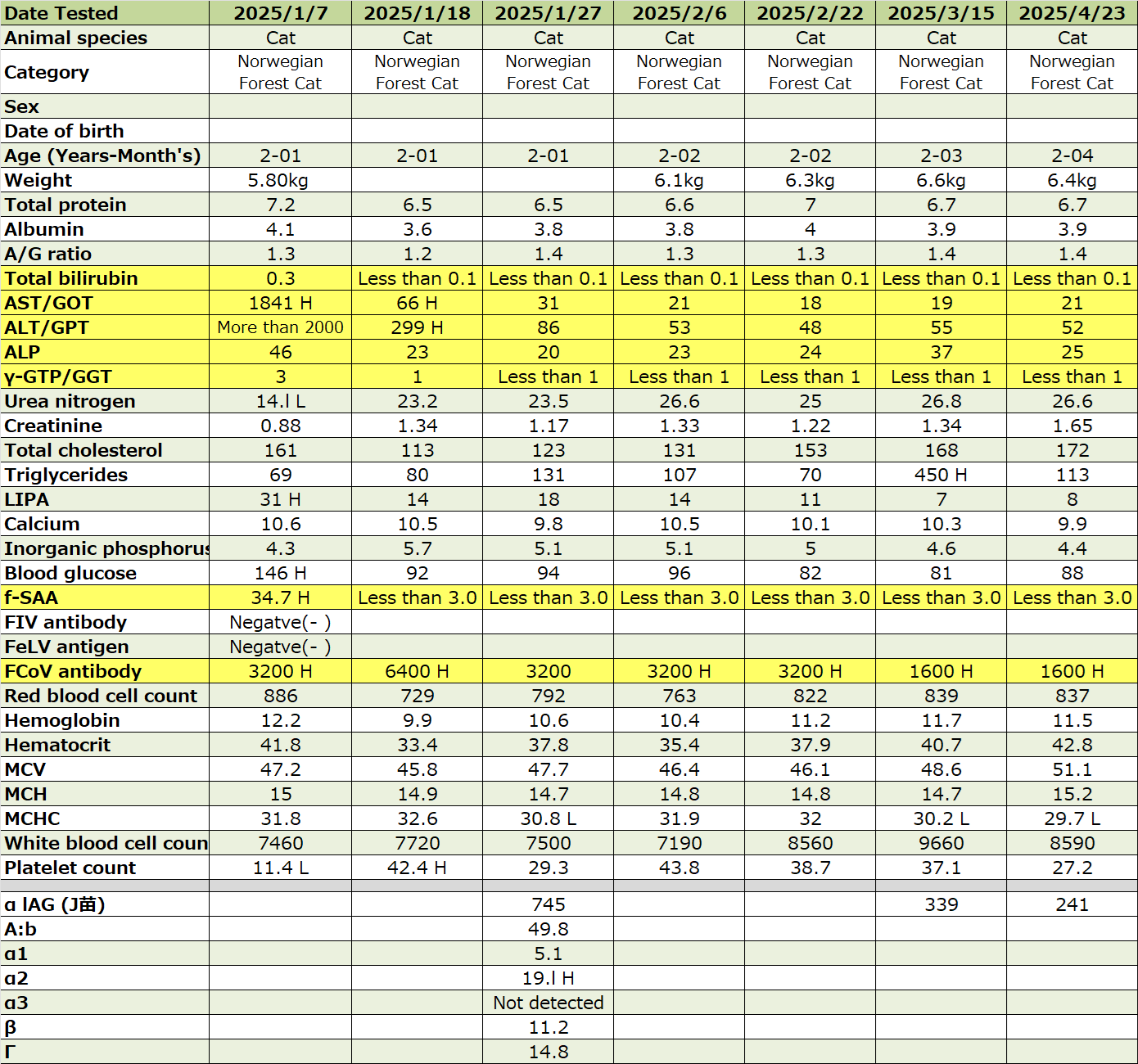
9.Canine: Lymphocytic Leukemia
Case number: C-008MDe
Dog, Chihuahua, unneutered male, born 2011/01/23, 13 years and 4 months, 2.2kg
Date of first visit: 2024/05/17
<Symptoms>
There were no systemic symptoms, and there were no problems with appetite or energy. The illness was discovered during a health check.
<Treatment>
Pure Gold 0.25ml, approximately 0.1ml/kg was used. Since then, it has been given orally every day.
From 05/17 to 05/22, only Pure Gold and a new quinolone antibiotic were given orally.
As the blood test on 05/22 showed no improvement in the values, an additional 2.5mg of prednisolone was given daily.
From 05/22 onwards, prednisolone, Pure Gold and a new quinolone antibiotic were given orally.
Due to various circumstances of the owner, it was decided to treat with oral medication only.
Its overall condition has always been good, and blood tests have progressed smoothly.
The treatment ended at the end of August.
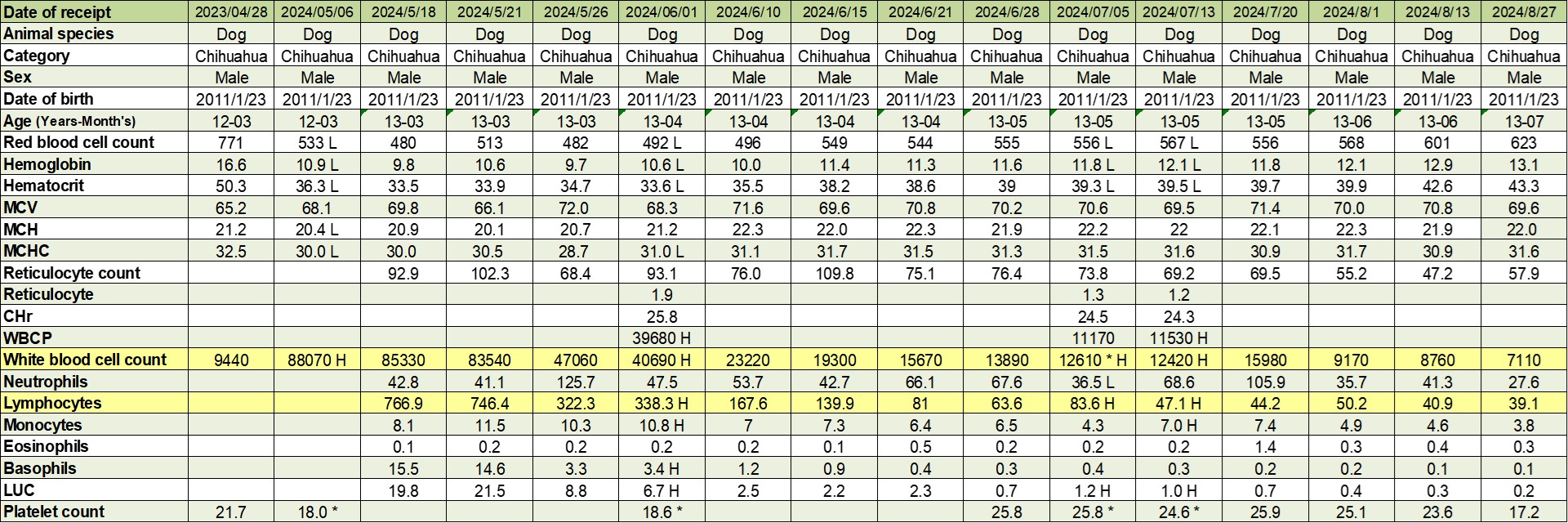
10.Canine: Herniated Disc Disease
① Inability to stand
Case number: V-001OBe
Dog, mixed breed, female, born 2023/05/13, 1 year and 1 month old, 3.4kg
First visit: 2024/06/23
<Symptoms>
It was brought in due to inability to stand up, It showed signs of deep pain sensation and some reflex reaction.
<Treatment>
Pure CBD 0.4ml, approximately 0.1ml/kg, was used. It has been administered orally every day since then. Prednisolone is also administered at 5mg every day. On 06/30, it stood up a little, and on 07/14, it recovered to the point where it could walk. Due to the owner’s circumstances, we chose to treat it with oral medication only.
<2024/06/30> Video #9-①-1
<2024/07/14> Video #9-①-2
② Inability to stand
Case number: V-002MRe
Dog, Miniature Dachshund, female, born 2014/02/24, 10 years and 4 months, 9kg
Date of first visit: 2024/07/16
<Symptoms>
It was unable to stand, had deep pain sensation, and had severe paralysis of the right hind leg.
<Treatment>
Pure CBD 1.0ml, approximately 0.1ml/kg, was used. This has been administered orally every day since. Prednisolone is also administered at 10mg daily. The patient was able to stand slightly on 07/31, and was able to walk on 08/04. It’s condition improved rapidly thereafter, and treatment was completed on 08/20. This case also chose to be treated with oral medication only.
<2024/07/16> Video #9-②-1
<2024/08/04> Video #9-②-2
③ Inability to stand
Case number: V-003KBe
Dog, Shiba Inu, neutered male, born 2013/04/01, 10 years and 11 months old, 5.8kg
First visit date: 2024/03/22
<Symptoms>
It was brought in due to inability to stand up, and had some deep pain sensation and some reflex reaction. The paralysis was severe. This case was transferred to our hospital after being told at another hospital that the condition could not be cured.
<Treatment>
Pure CBD 0.75ml, approximately 0.1ml/kg, was used. Has been administered orally daily since. Prednisolone 10mg administered daily, and therapeutic laser treatment also used. On 05/02, the patient stood up slightly, walked a little on 05/07, and recovered to a state where he could walk, albeit unsteadily, on 05/20. Prednisolone is being tapered depending on symptoms.
The video was taken on 07/27. The severity of the condition can be seen from the way the patient walks.
Video #9-③-1
④ Inability to stand
Case number: C-019SM
Dog, Papillon, unneutered female, born 2017/02/01, 8 years 0 months, 7.2kg
First visit: 2025/02/10
<Symptoms>
Came to the hospital complaining of inability to stand, deep pain sensation, incomplete paralysis, unable to walk.
<Treatment>
Used pure CBD 0.7ml, approximately 0.1ml/kg. Has been administered orally every day since. Prednisolone 2mg/kg daily. After that, on 02/14, she started walking a little, so the dosage of prednisolone was reduced to 1.5mg/kg. On 02/16, she recovered completely and was able to walk, and the dosage of prednisolone was reduced to 0.7mg/kg. She recovered so smoothly that she was able to walk one week from the first visit, so we continued administering prednisolone 0.7mg/kg for another week to prevent the symptoms from recurring.
<2025/02/10>
<2025/02/14>
<2025/02/16>
11.Feline: Infectious Peritonitis
11-1 British Shorthair
Case number: F-009MBe
Cat, British shorthair, neutered female, born 2014/02/24, 10 years and 4 months old, 5.2kg
Date of first visit: 2024/05/31
<Symptoms>
It was brought in due to a high fever of 40.0℃ and lack of vitality.
<Treatment>
Pure CBD 0.5ml, approximately 0.1ml/kg was used. It was given orally every day thereafter. Oral administration of new quinolone antibiotics was also given daily. Treatment did not improve the condition, and pleural fluid accumulation was confirmed. From 06/07, the CBD was changed from Pure CBD to Pure Gold. Although the temperature was 39.5°C, the appetite was consistent and there were no problems.
A definitive diagnosis of feline infectious peritonitis was made, and from 06/09, Molnupiravir capsules were started at 1/2 cap twice a day. At the same time, the Pure Gold was increased to 0.5ml twice a day. By 06/12, the temperature had dropped to 38.5°C, and an X-ray examination on 06/15 confirmed a decrease in pleural fluid accumulation. At the owner’s request based on an internet source, Molnupiravir was continued to be given orally until 06/25. However, on June 25th, blood test results showed a decrease in white blood cell count and hemolysis (jaundice), so the administration of Molnupiravir was discontinued. After that, the owner complained that the medication was difficult to administer, so the treatment was terminated and the dog was placed under observation. Up until now, It’s overall condition has been good.
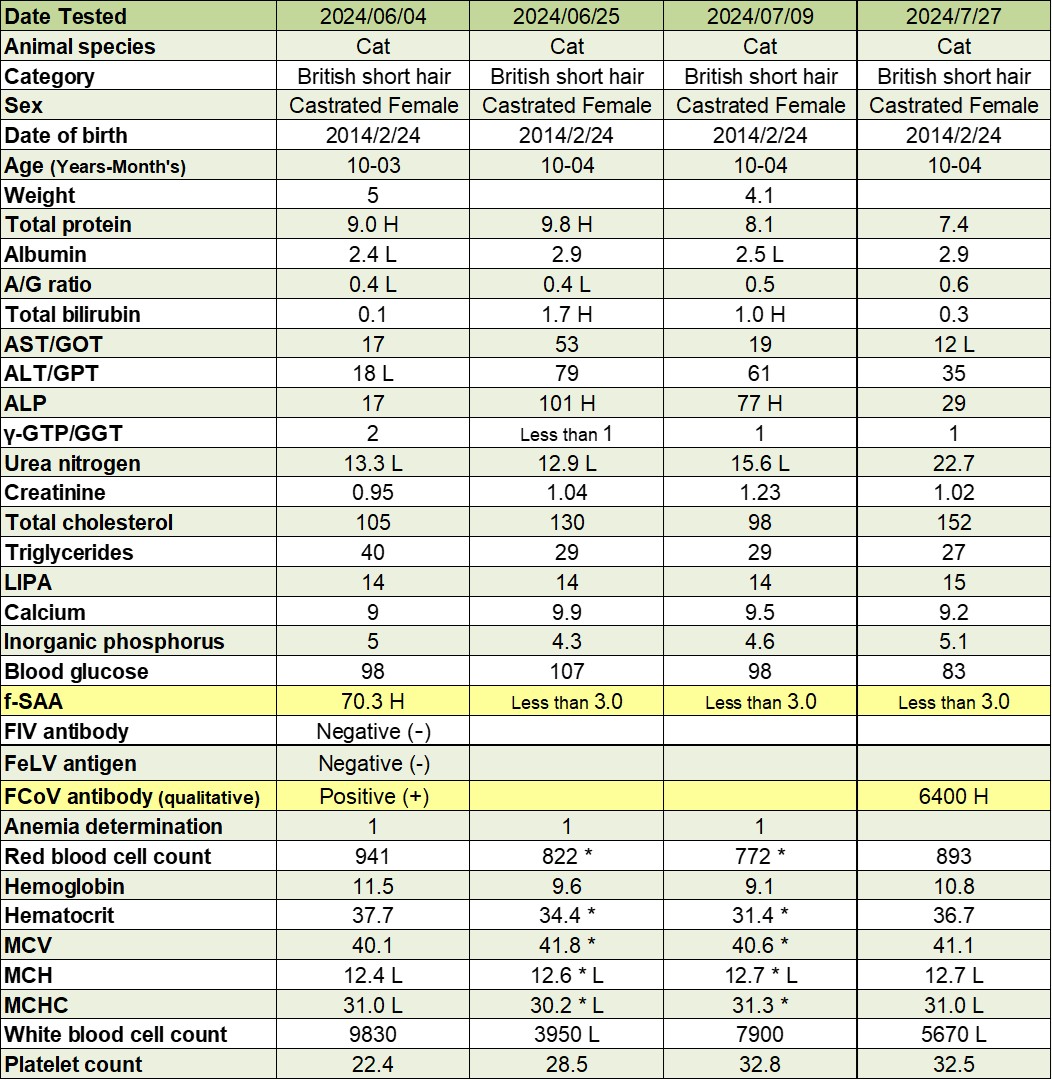
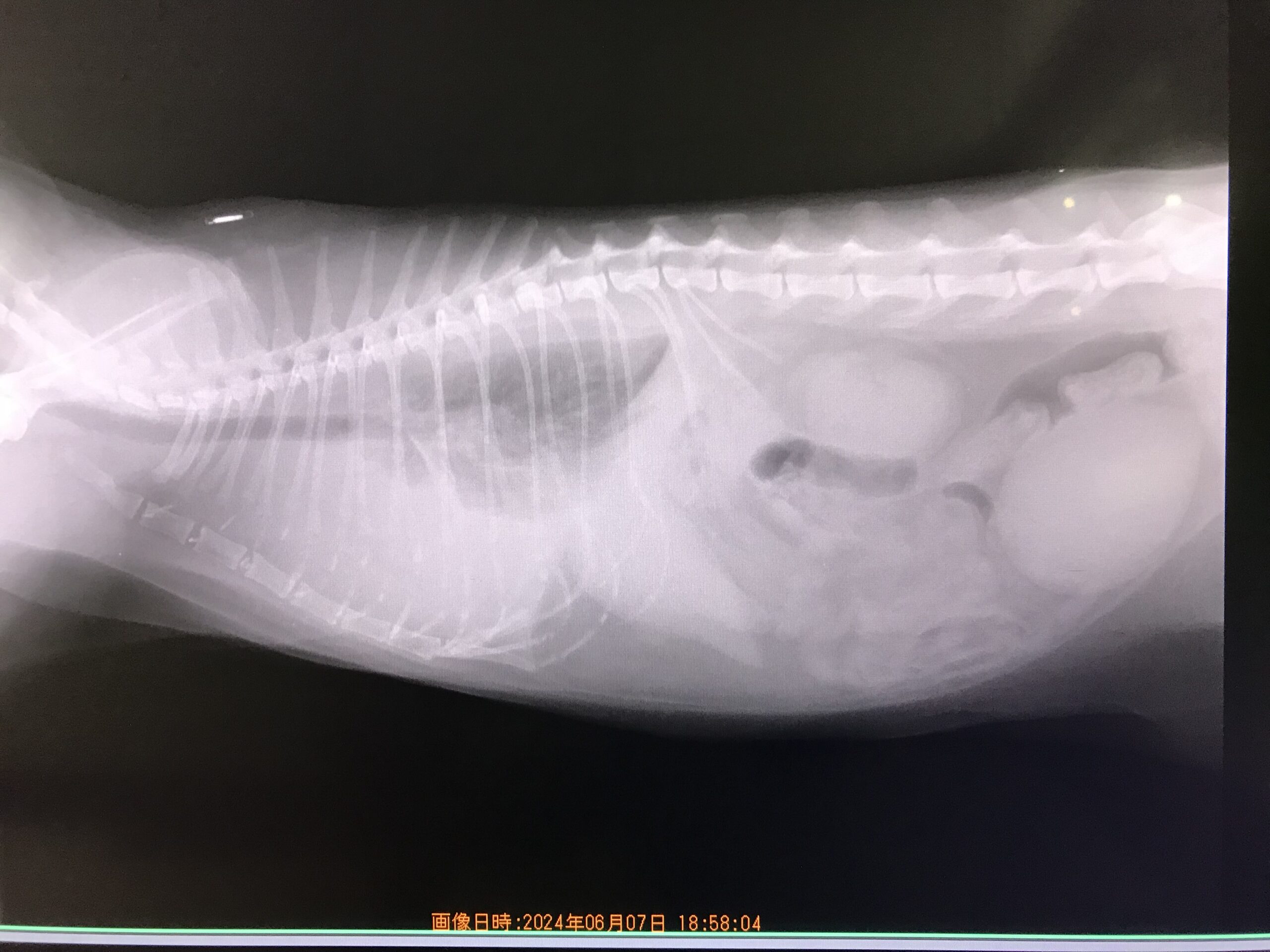
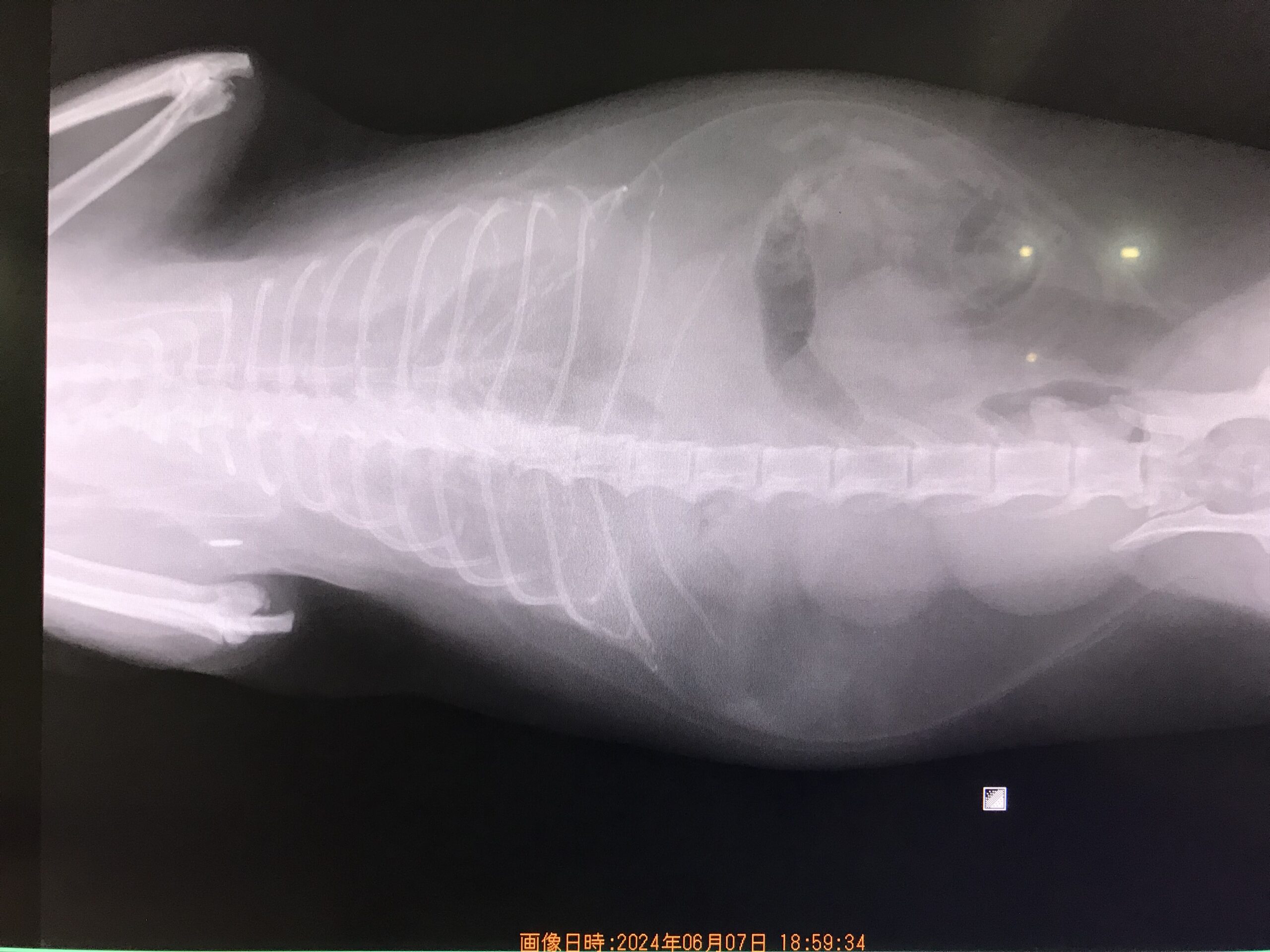
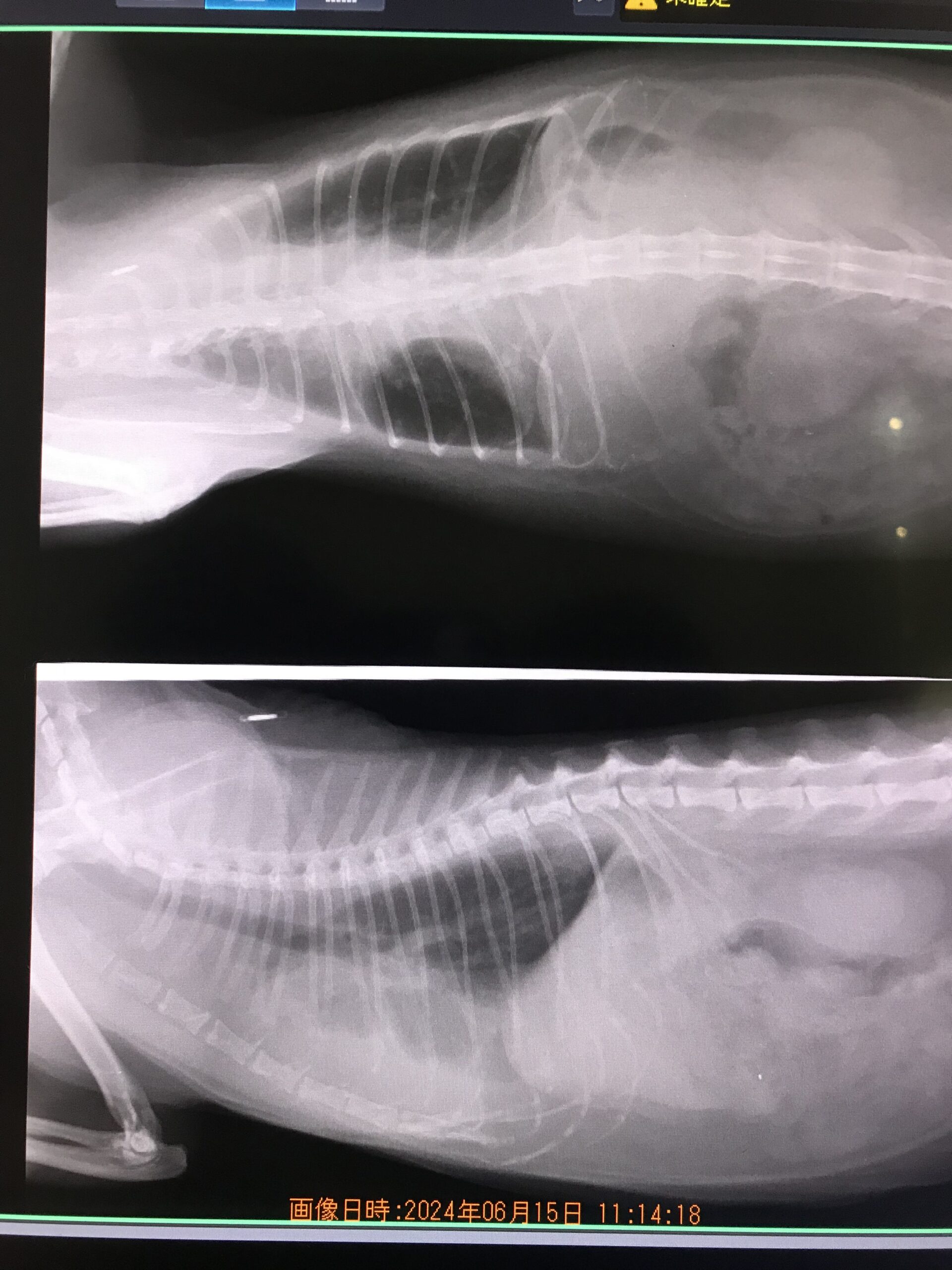
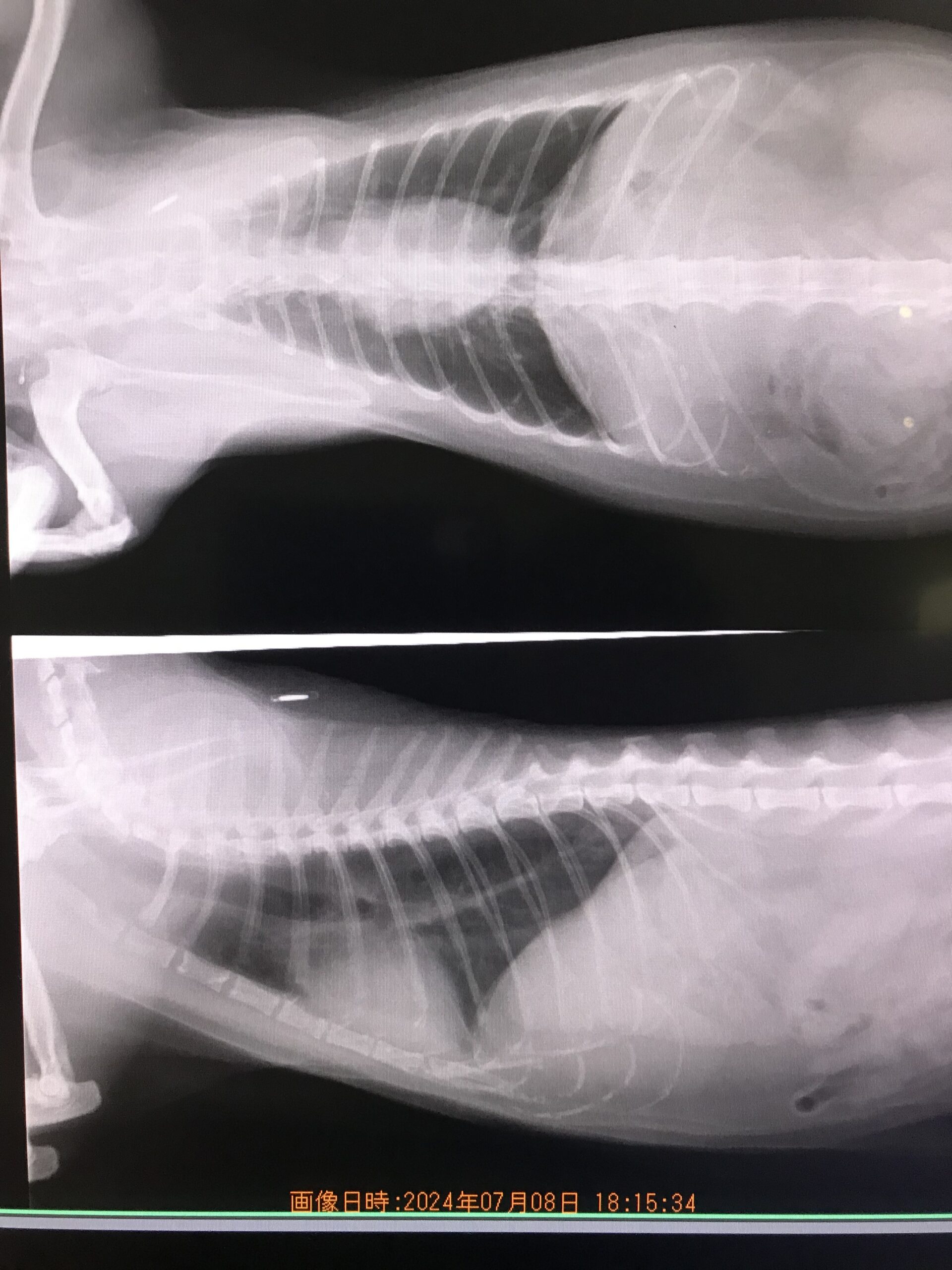
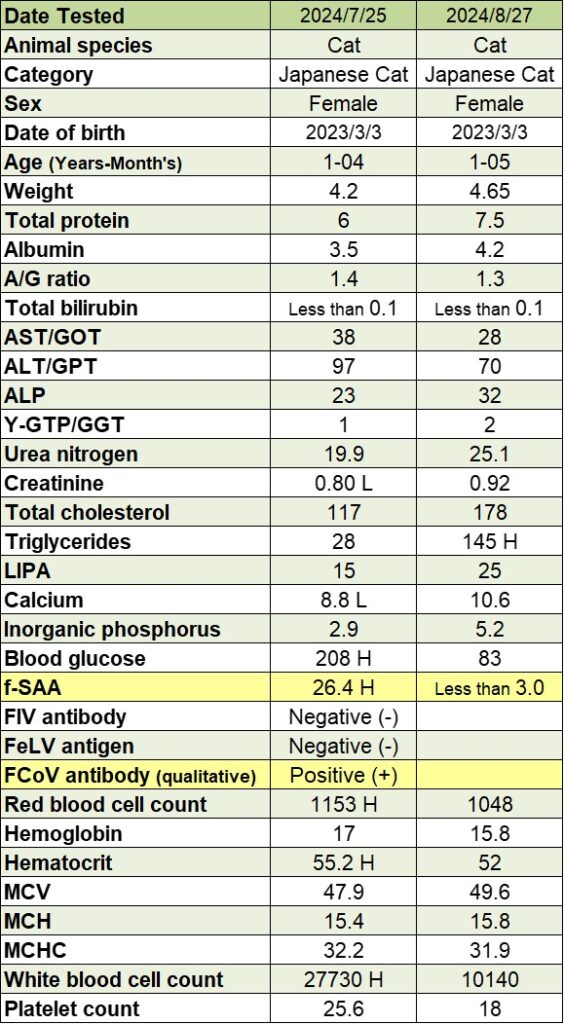
11-3 Bengal
Case number: F-011BGe
Cat, Bengal, female, born 2023/01/01, 9 months, 2.5kg
First visit: 2023/09/05
<Symptoms>
It was brought in due to a high fever of 40.2℃ and lack of vitality.
<Treatment>
Pure CBD 0.3ml, approximately 0.1ml/kg, was used. Since then, it has been orally administered daily. Convenia injections were also administered at the same time. Subcutaneous fluid replacement was not performed due to a good appetite. Due to various reasons from the owner, medication for Molnupiravir was not administered. The chronological details of blood test results since then have been recorded as data. After one month of treatment, the overall condition has been good to date.
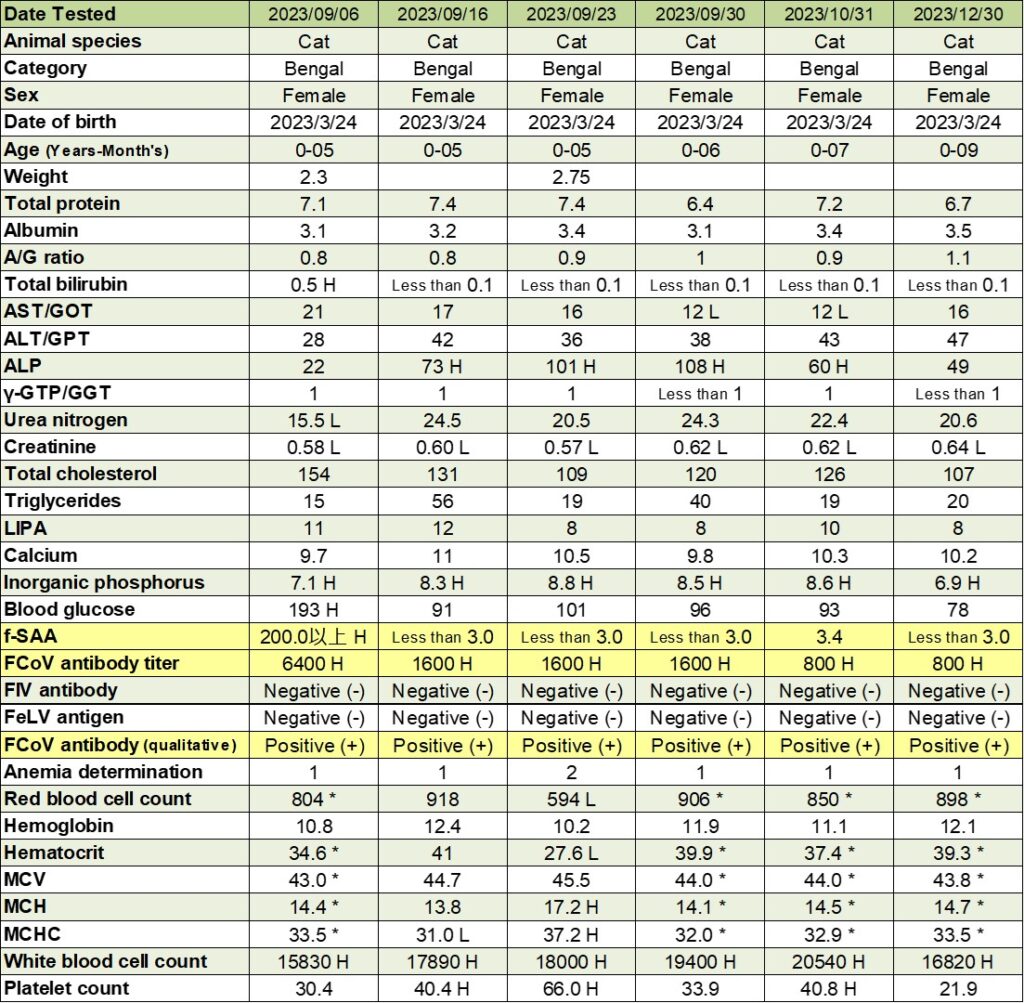
11-4 Bengal
Case number: F-012RDe
Cat, Ragdoll, female, born 2022/05/01, 2 years and 2 months, 2.4kg
First visit date: 2024/07/28
<Symptoms>
It was brought in due to a high fever of 39.5℃ and lack of vitality.体温39.5℃. No weight gain in spite of food intake.
<Treatment>
Pure Gold 0.3ml, approximately 0.1ml/kg was used. It has been administered orally every day since then. Antibiotics were not used at the same time, and subcutaneous fluid administration was not performed because the appetite was good. Due to various reasons of the owner, the administration of Molnupiravir was not performed. By 2024/09/01, the weight had increased to 3kg. The overall condition is good to date.
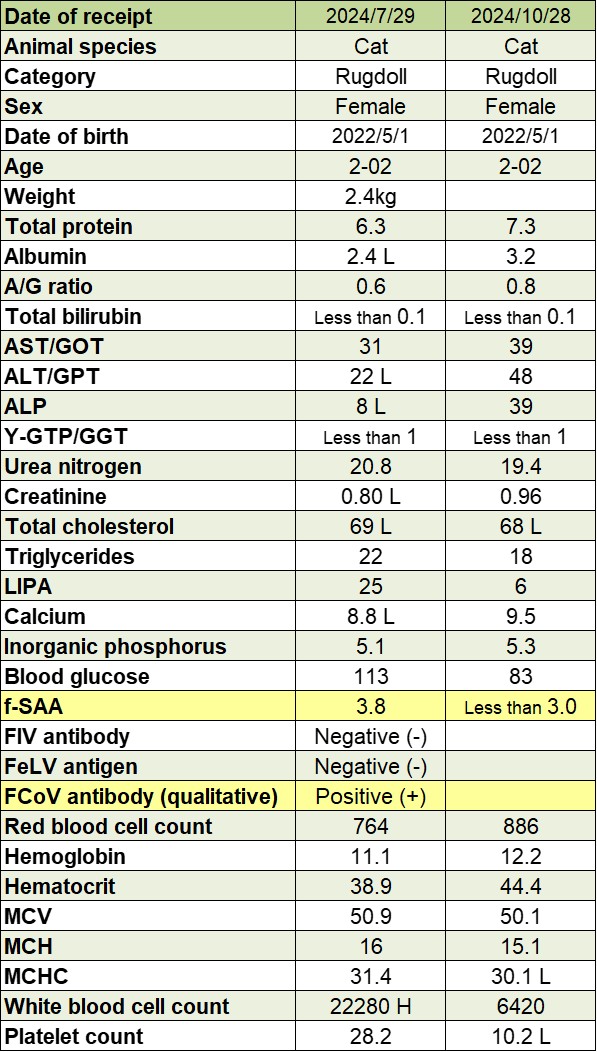
Back to Page Top
11-5 Munchkin
Case number: F-018TU
Cat, Munchkin, unneutered female, born 2024/07/04, 0 years 6 months, 1.8kg
First visit: 2025/02/03
<Symptoms>
Visited with a complaint of body temperature of 40.0℃ and diarrhea that would not improve.
<Treatment>
On the first day, a quinolone antibiotic was administered to treat the diarrhea, but it was completely ineffective. An immune disease was suspected, and prednisolone was administered on the third day of the visit. This improved the diarrhea, but the fever did not change from 40℃. Although the cat had a consistent appetite, it was stunted and small in size. As a result, a test was performed to suspect a potential viral disease, and the test results were obtained on 02/05. The total protein, especially the gamma globulin value, was high, and the FcoV antibody titer was .102400 or more and .2811 α-1AG. FcoV antibody titer. 102,400 or more is the first time I have seen such a value, and I was surprised that such a value exists. There is no doubt that the gamma globulin and alpha-1AG values are also quite high.
Pure Gold 0.15ml, approximately 0.1ml/kg, was used. It was administered orally once a day every day. The patient was treated with a new quinolone antibiotic and prednisolone 1.25mg, but due to the diagnosis of feline infectious peritonitis, the Pure Gold 0.15ml was also increased to oral administration twice a day. In addition, the anti-coronavirus drug Molnupiravir capsule was administered at 1/6 cap twice a day from 02/11. Molnupiravir was administered orally until 02/18. The method of administration of Molnupiravir for humans is to administer it for 5 days, but in this case it was administered for a little longer. Administration of prednisolone 1.25mg was temporarily suspended due to consideration of viral infection. However, the diarrhea recurred when only Molnupiravir, new quinolone antibiotics, and Pure Gold were administered, so on 02/17, prednisolone administration was resumed and the diarrhea subsided. For a while, Molnupiravir was not administered, and the patient was maintained on new quinolone antibiotics, prednisolone, and Pure Gold, but on 02/24, the patient presented with symptoms of diarrhea and hypoglycemia and visited the hospital, where treatment improved the patient’s condition. From this point, the prednisolone was increased to 1.7mg, Pure Gold was changed to CBG, Molnupiravir was administered again, and new quinolone antibiotics were continued. A blood test on 02/27 confirmed that the disease had not yet progressed, with FcoV antibody titer of .25600, α-1AG of .2365, and white blood cell count of 38910, and Molnupiravir was administered until 03/21 while monitoring the white blood cell count. A blood test on 24/03 showed an improvement in the FcoV antibody titer to .6400 and α-1AG titer to .985, so the medication was changed to oral administration of CBG 0.075ml once a day. However, diarrhea recurred, and the diarrhea is currently being managed with a new quinolone antibiotic, prednisolone 1.25mg, and CBG 0.075ml.
The diarrhea is suspected to be an immune disease rather than a symptom of feline infectious peritonitis, and is beginning to suspect that it may be a characteristic of British cats. The author himself has frequently encountered chronic diarrhea and rheumatoid arthritis in other British cats. In these cases, the treatment has been successful with prednisolone and Pure Gold.
